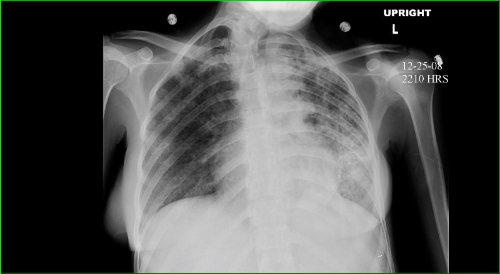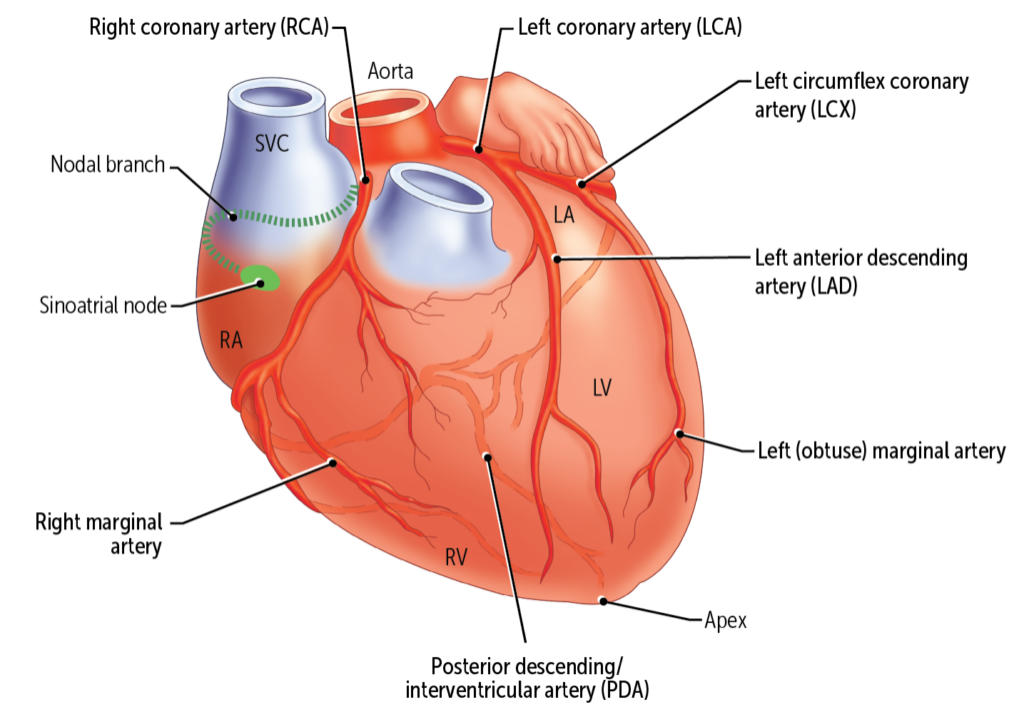A 33-year-old man presents for a follow-up visit after his pre-employment health screen revealed a concerning finding. He has lost 25 pounds over the last 4 months but claims that he has not altered his usual exercise or dietary habits. He reports having a productive cough during the last month and that he was incarcerated recently. The patient emigrated from China 5 years ago and had returned to visit his family 6 months ago. He denies contact with any sick individuals.
On examination, the patient appears alert and oriented. His temperature is 37.5°C (99.5°F), blood pressure is 130/85 mm Hg, and heart rate is 84. He has no pallor, scleral icterus, or evidence of cervical lymphadenopathy. No rales or wheezes are heard on auscultation of his chest, and there is no dullness or hyperresonance. His trachea is midline, and chest expansion is symmetric. The rest of the examination findings are normal. The result of an HIV antigen/antibody test is negative. A chest x-ray is obtained, and the findings are similar to those seen on a chest x-ray obtained from a female patient (see image).

Which of the following describes the lung pathology of the most likely diagnosis? Explain why in the comments.
A. Abundant 2-mm foci of consolidation representing caseating granulomas on a gross pathologic specimen
B. Laminated, concentric, calcific spherules
C. Multinucleated giant cells and epithelioid cells surrounding central caseation and calcification
D. Noncaseating granulomas with nodal aggregates of epithelioid cells
E. Peroxidase-positive cytoplasmic inclusions in granulocytes
F. Poorly formed granulomas surrounded by lymphocytes and plasma cells, in addition to epithelioid and giant cells surrounding a small artery
Want to know the ‘bottom line?’ Purchase a USMLE-Rx Subscription and get more questions, answers, and context in a system fully integrated with First Aid, including images, references, and other high yield facts.
This practice question is an actual question from the USMLE-Rx Step 1 Qmax test bank. For more USMLE Step 1 prep, subscribe to our First Aid Step 1 Flash Facts and First Aid Step 1 Express Videos video series. Score the best deal on all three products as a bundle with USMLE-Rx 360 Step 1.




A
TB
C
M. Tub.
First choice A. Clearly TB
Clearly CXR shows TB left lung consolidation
And (most common) cause in China/India/subcontinent countries is TB
+ H/O weight loss
+ H/O emmigration
So I would go for
C)
Guys I don’t think so granulomas are visible on gross specimen
Granulomas are a feature of microscopic examination
Agree
Answer is A
The answer is C. This patient’s recent history of weight loss and a productive cough and the chest x-ray findings after a visit to a region in which tuberculosis (TB) is endemic indicate that he most likely has an infection with Mycobacterium tuberculosis. Patients with primary M. tuberculosis infections tend to remain free of symptoms. However, reactivation of the bacteria causes pulmonary TB, which can be characterized by night sweats, weight loss, and pulmonary symptoms. TB can be identified on a chest x-ray as a Ghon complex, which is a calcified focus of the infection. Histologically, a Ghon complex consists of caseating granulomas with multinucleated giant cells and epithelioid cells surrounding an area of central necrosis. This finding is associated with lymph node involvement.
Diffuse foci of consolidation with caseating granulomas are seen in patients with miliary tuberculosis. Laminated concentric spherules, also called psammoma bodies, are associated with several malignancies, including mesothelioma. Noncaseating granulomas with nodal aggregates of epithelioid cells are seen in patients with sarcoidosis. Peroxidase-positive cytoplasmic inclusions in granulocytes are seen in patients with acute promyelocytic leukemia. Poorly formed granulomas surrounded by lymphocytes and plasma cells, in addition to epithelioid and giant cells surrounding a small artery, can be seen in patients with Wegener granulomatosis.
To sum it up, the best hot tub are those that you can fully enjoy in your backyard whenever you want. These are also great for people who are interested in rejuvenating their bodies and are willing to spend extra money on this purpose. No matter what you prefer, these are the best options for your needs and budget.